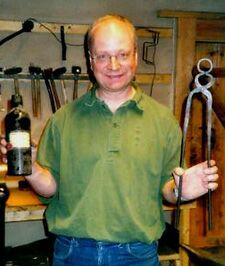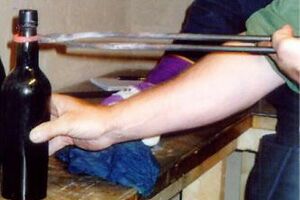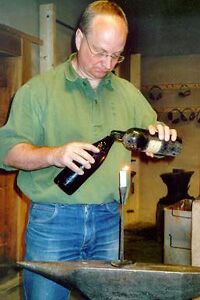 |
| The happy blacksmith with his tongs. |
Article and photos © copyright 2004 by Anders Källberg
I have a certain love for learning old-time techniques, in particular those that are or have been on the verge of becoming extinct. It gives me a particular pleasure to work with my hands, only using simple tools, such as a knife, for instance, when I'm carving things in wood. From wood carving quite a lot, I've become interested in making my own knives.
I've bought hand made blades from blacksmiths and attached handles to them, but I've been longing to make my own knife blade too. Thus, I registered for a week-long course in blacksmithing.
I realized that I would not be able to make a knife already in this first, basic course, so I thought of another goal for the course: making a pair of port tongs.
The course was very interesting. We learned most of the basic skills and techniques that are used in blacksmithing. They are not very complicated, so you can really learn how they are done in a week, but, of course a lot of practice is needed to master them. Anyway, on the last day of the course, I was able to make my own port tongs.
In fact I've never seen one in real life, so I searched the internet for what it basically should look like, and made a design that I hoped would work.
 |
| The glowing tongs around the neck of the bottle. |
So the tongs were put among the glowing coals in the forge and when growing bright red it was put around the neck of the bottle. It was made so it would fit just below the cork.
The tongs were removed and when the neck was barely touched with a wet cloth, a faint, but sharp crack could be heard, and the top of the bottle, including the cork could be lifted free from the rest.
A success! A nice, clean cut of the bottle, without any sharp splinters. No problems having to try to extract the old soft cork from the bottle. Indeed the perfect way to open a bottle of vintage port!
Oh, yes, the tasting note. Here it is:
 |
| The decanting of the wine. |
Light orange brown, nice lustre, like amber.
Lovely nose of sweet, dried fruits, in particular figs and raisins. After some time heavier aromas of tobacco, smoke and tea emerged.
Sweet taste with a very well preserved fruit, very much reflecting the nose. Long, most pleasant aftertaste.
As you can imagine, my fellow smith mates at the course and also quite a few other people that were at the same place attending other courses, were intrigued to be able to taste such a fine old wine and I was very happy to be able to give them this experience. There was even one person there that was born in 1947, which pleased me even more.
I have tasted this wine once before and this bottle was much better than the previous one, which was rather dried out and dull. This one still had a lively fruit left, which really made it sing. Of course, the special occasion also helped a bit, I'd guess...
Let me know if any of you have your own experiences using port tongs.
Cheers, Anders
PS: BTW, my next goal in my smithing career is to make a sabre, to be used when sabering Champagne. I'll send you a report when I'm there. :-)
Anders Källberg is a Swedish winelover and hobbyist blacksmith. If you would like to contact him for information about his Port tongs, write us at wine@wineloverspage.com, and we'll pass your message along.
July 28, 2004




